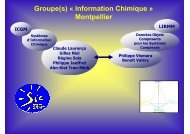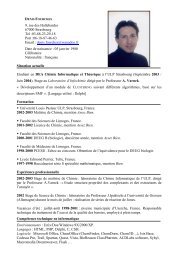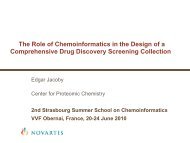International Summer School PROGRAM - Laboratoire d'Infochimie ...
International Summer School PROGRAM - Laboratoire d'Infochimie ...
International Summer School PROGRAM - Laboratoire d'Infochimie ...
You also want an ePaper? Increase the reach of your titles
YUMPU automatically turns print PDFs into web optimized ePapers that Google loves.
What does the recognition of biomolecules and switchable nanoassemblies have<br />
in common? Interacting Molecules!<br />
Prof. Dr. Carsten Schmuck, Universität Duisburg-Essen, Universitätsstrasse 7,<br />
45141 Essen, Germany<br />
The lecture will focus on some recent achievements from our laboratory giving an<br />
overview of the research going on in our group. Our research focuses on the<br />
development, synthesis and evaluation of new supramolecular systems which function<br />
in polar solvents and thus might have prospect for applications. Currently our work<br />
mainly involves ionic interactions as a key non-covalent bond. We have introduced<br />
guanidiniocarbonyl pyrroles as one of the most efficient oxoanion binding motifs known<br />
so far relying on H-bond assisted ion pair formation. The systematic thermodynamic<br />
study of knock-out analogues allows us to learn more about the importance of<br />
individual non-covalent interactions for the overall binding affinity.<br />
With the help of combinatorial approaches, we have used this binding motif to develop<br />
sensors for amino acids or highly efficient stereoselective receptors for oligopeptides.<br />
Currently, we are working on protein surface or DNA recognition. For example,<br />
tetravalent peptide ligands identified from the screening of a combinatorial library were<br />
shown to be highly efficient non-competitive enzyme inhibitors working by binding to<br />
the protein surface thus blocking the access to the active site.<br />
We are also interested in self-assembling zwitterions which form soft materials such as<br />
vesicles, polymers or monolayers in polar solvents and on surfaces. For example, very<br />
recently we developed a supramolecular polymer based on a monomer with two<br />
orthogonal self-complementary binding sites using either metal-ligand or ionic<br />
interactions. In a hierarchical self-assembly process this molecule first forms ion paired<br />
dimers which can be polymerized by the addition of metal ions.









